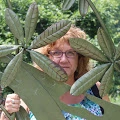This post is a follow-up to to a post from November of 2016.
I am shocked that it has been almost two years!
That fall I reported on a disappearing fern.
One of my favorite babies was disappearing.
Further inspection showed that caterpillar was eating my coveted
Dragon’s tail fern, Aspleniaceae x Ebenoides.
After attempts to save what was left of the little fern,
I decided my best hope for a future for the fern was for future offspring.
I placed the remaining fronds face down on sterile seed-starting mix in a sealed glass jar.
Green slowly appeared months later. This tiny green growth was the gametophyte stage of the fern.
This week, while trapped inside during Hurricane Florence, I notice the first tiny frond.
A fern is born! In only two short years!
If you are into gardening for the long game, try starting ferns.
It will make watching grass grow seem fast-paced and exciting.
MAMA FERN/ FLOWER/SLOWFLOW











